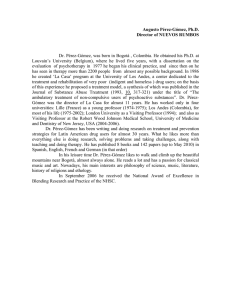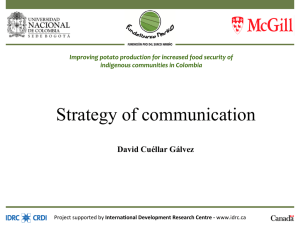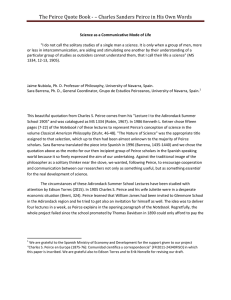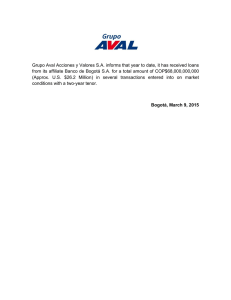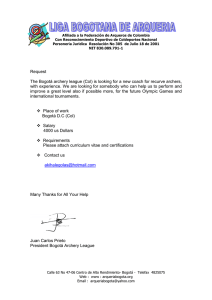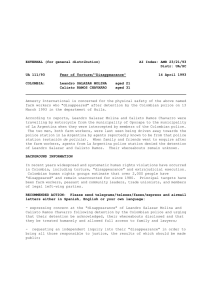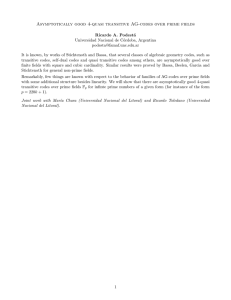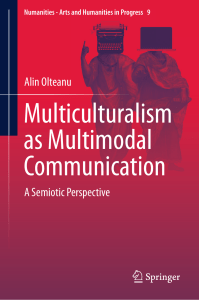Peirce`s Reception in Colombia As has happened in Latin America
Anuncio
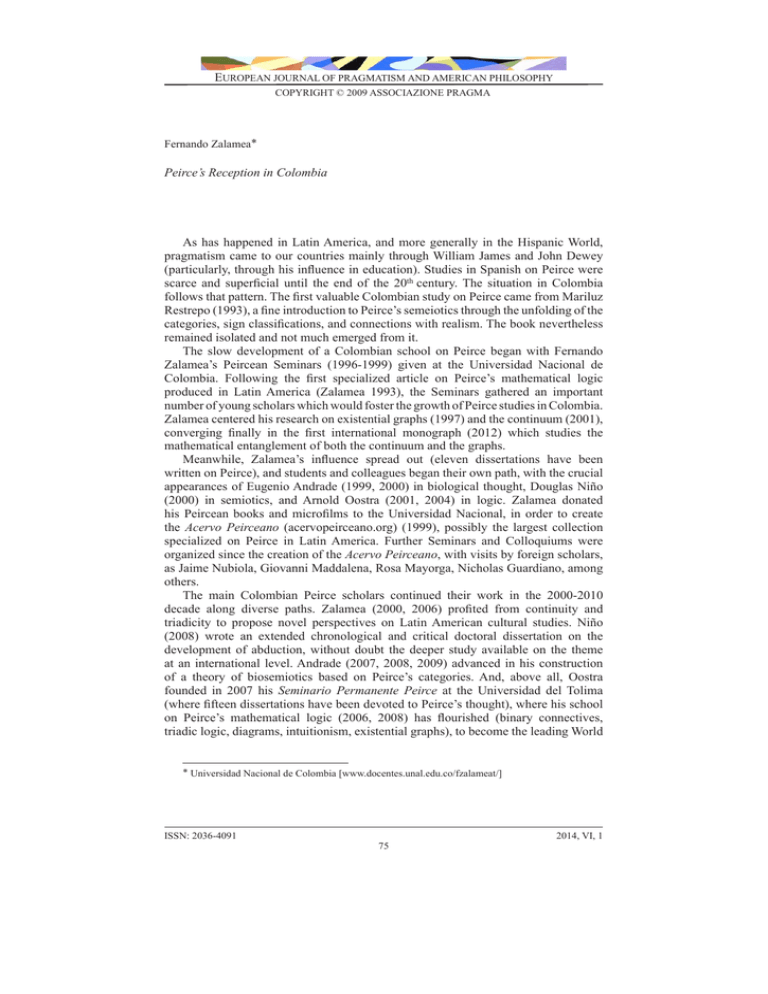
EUROPEAN JOURNAL OF PRAGMATISM AND AMERICAN PHILOSOPHY COPYRIGHT © 2009 ASSOCIAZIONE PRAGMA Fernando Zalamea* Peirce’s Reception in Colombia As has happened in Latin America, and more generally in the Hispanic World, pragmatism came to our countries mainly through William James and John Dewey (particularly, through his influence in education). Studies in Spanish on Peirce were scarce and superficial until the end of the 20th century. The situation in Colombia follows that pattern. The first valuable Colombian study on Peirce came from Mariluz Restrepo (1993), a fine introduction to Peirce’s semeiotics through the unfolding of the categories, sign classifications, and connections with realism. The book nevertheless remained isolated and not much emerged from it. The slow development of a Colombian school on Peirce began with Fernando Zalamea’s Peircean Seminars (1996-1999) given at the Universidad Nacional de Colombia. Following the first specialized article on Peirce’s mathematical logic produced in Latin America (Zalamea 1993), the Seminars gathered an important number of young scholars which would foster the growth of Peirce studies in Colombia. Zalamea centered his research on existential graphs (1997) and the continuum (2001), converging finally in the first international monograph (2012) which studies the mathematical entanglement of both the continuum and the graphs. Meanwhile, Zalamea’s influence spread out (eleven dissertations have been written on Peirce), and students and colleagues began their own path, with the crucial appearances of Eugenio Andrade (1999, 2000) in biological thought, Douglas Niño (2000) in semiotics, and Arnold Oostra (2001, 2004) in logic. Zalamea donated his Peircean books and microfilms to the Universidad Nacional, in order to create the Acervo Peirceano (acervopeirceano.org) (1999), possibly the largest collection specialized on Peirce in Latin America. Further Seminars and Colloquiums were organized since the creation of the Acervo Peirceano, with visits by foreign scholars, as Jaime Nubiola, Giovanni Maddalena, Rosa Mayorga, Nicholas Guardiano, among others. The main Colombian Peirce scholars continued their work in the 2000-2010 decade along diverse paths. Zalamea (2000, 2006) profited from continuity and triadicity to propose novel perspectives on Latin American cultural studies. Niño (2008) wrote an extended chronological and critical doctoral dissertation on the development of abduction, without doubt the deeper study available on the theme at an international level. Andrade (2007, 2008, 2009) advanced in his construction of a theory of biosemiotics based on Peirce’s categories. And, above all, Oostra founded in 2007 his Seminario Permanente Peirce at the Universidad del Tolima (where fifteen dissertations have been devoted to Peirce’s thought), where his school on Peirce’s mathematical logic (2006, 2008) has flourished (binary connectives, triadic logic, diagrams, intuitionism, existential graphs), to become the leading World * Universidad Nacional de Colombia [www.docentes.unal.edu.co/fzalameat/] ISSN: 2036-4091 75 2014, VI, 1 Fernando ZalameaPeirce’s R eception in Colombia center specialized in Peirce’s graphs (Oostra’s 2010-2011, invention/discovery of the intuitionistic existential graphs being a major breakthrough). Time was ripe to organize the community and Zalamea created the Centro de Sistemática Peirceana (CSP) in 2007. The CSP has oriented its main task to the production of a yearly journal devoted to Peirce, the Cuadernos de Sistemática Peirceana (pdfs available at acervopeirceano.org). The first five numbers of the journal (Zalamea & Oostra 2009-2013) have been written in Spanish by the local Colombian community of the CSP: Eugenio Andrade (biology), Gonzalo Baquero (philosophy), Carlos Garzón (philosophy), Lorena Ham (linguistics), Richard Kalil (philosophy), Jaime Lozano (economy), Alejandro Martín (mathematics), Douglas Niño (semiotics), Arnold Oostra (mathematics), Roberto Perry† (phonetics), Laura Pinilla (medicine), Miguel Ángel Riaño (philosophy), Edison Torres (philosophy), Fernando Zalamea (mathematics). One can consider a small feat the organization of such a multiverse community and its capacity to maintain a journal devoted specifically to Peirce (a unique fact, since even the Transactions extends itself towards general American philosophy). In contraposition with the initial local perspective, the next five numbers of the Cuadernos will be oriented to articles by the global community (many languages represented, not just English) around monographic numbers: Esthetics (2014), Mathematics (2015), Existential Graphs (2016), etc. Peirce would certainly have been intrigued to see a devoted community working on his heritage in a remote country that he never would have dreamed of. References (selected Peirce Publications produced by Colombian scholars) Andrade E., (1999), “Natural selection and Maxwell demon’s: a Semiotic approach to Evolutionary Biology,” Semiotica 127 (1) (special issue Biosemiotica, eds. Hoffmeyer & Emmeche), 133-49. —(2000), Los demonios de Darwin: Semiótica y Termodinámica de la Evolución biológicas, Bogotá, Unibiblos. — (2007), “The Semiotic Framework of Evolutionary and Developmental Biology,” Biosystems 90 (2), 389-404. — (2008), “From a dynamical to a semiotic account of emergence,” Cybernetics and Human Knowing 15 (3-4), 87-96 (http://acervopeirceano.org/articulos-en-linea/). —(2009), La ontogenia del pensamiento evolutivo, Bogotá, Universidad Nacional de Colombia. ISSN: 2036-4091 76 2014, VI, 1 Fernando ZalameaPeirce’s R eception in Colombia Niño D., (2000), “El enfermar como semiosis. Contribución para una crítica lógicosemiótica de la práctica médica,” M. A. Thesis, Bogotá, Universidad Nacional de Colombia. — (2008), “Abducting Abduction. Avatares de la comprensión de la abducción de Charles S. Peirce” (Abducting Abduction. Vicissitudes in the Comprehension of Charles S. Peirce’s Abduction), Ph.D. Thesis, Bogotá, Universidad Nacional de Colombia. Oostra A., (2001), “Simetría y Lógica: la notación de Peirce para los 16 conectivos binarios” (with Mireya García – Jhon Fredy Gómez), Memorias del XII Encuentro de Geometría y sus Aplicaciones, Bogotá, Universidad Pedagógica Nacional, 1-26. — (2004), “La notación diagramática de C. S. Peirce para los conectivos proposicionales binarios,” Revista de la Academia Colombiana de Ciencias 28 (106), 57-70, (http://acervopeirceano.org/articulos-en-linea/). — (2006), “Peirce y la matemática,” Anthropos 212, 151-59, (http://acervopeirceano. org/articulos-en-linea/). — (2008), “Una reseña de la lógica matemática de Charles S. Peirce (1839–1914),” REVISTA Universidad EAFIT 44 (150), 9-20, (http://acervopeirceano.org/articulosen-linea/). —(2010), “Los gráficos Alfa de Peirce aplicados a la lógica intuicionista,” Cuadernos de Sistemática Peirceana 2, 25-60. — (2011), “Gráficos existenciales Beta intuicionistas,” Cuadernos de Sistemática Peirceana 3, 53-78. Restrepo M., (1993), Ser-Signo-Interpretante. Filosofía de la representación de Charles S. Peirce, Bogotá, Significantes de Papel Ediciones. Zalamea F., (1993), “Una jabalina lanzada hacia el futuro: anticipos y aportes de C. S. Peirce a la lógica matemática del siglo XX,” Mathesis 9 (4), 391-404. —(1997), Lógica topológica: una introducción a los gráficos existenciales de Peirce, Reportes del XV Coloquio Distrital de Matemáticas, Bogotá, Universidad Nacional de Colombia. —(2000), Ariel y Arisbe. Evolución y evaluación del concepto de América Latina en el siglo XX: una visión crítica desde la lógica contemporánea y la arquitectónica pragmática de C. S. Peirce, Bogotá, Convenio Andrés Bello. ISSN: 2036-4091 77 2014, VI, 1 Fernando ZalameaPeirce’s R eception in Colombia —(2001), El continuo peirceano, Bogotá, Universidad Nacional de Colombia. —(2006), Signos triádicos. Lógicas – literaturas – artes. latinoamericanos, México, Mathesis. Nueve estudios —(2012), Peirce’s Logic of Continuity. A Conceptual and Mathematical Approach, Boston, Docent Press. Zalamea F. – Oostra A., (2009-2013), Cuadernos de Sistemática Peirceana (Fernando Zalamea – Arnold Oostra, editors), Vol. 1 (2009), Vol. 2 (2010), Vol. 3 (2011), Vol. 4 (2012), Vol. 5 (2013). ISSN: 2036-4091 78 2014, VI, 1
